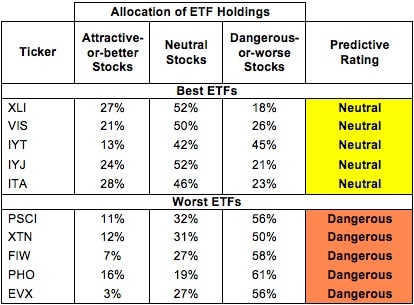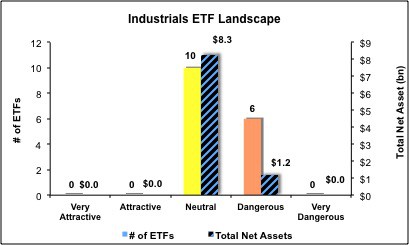The Industrials sector ranks third out of the ten sectors as detailed in my Sector Rankings for ETFs and Mutual Funds report. It gets my Neutral rating, which is based on aggregation of ratings of 16 ETFs and 18 mutual funds in the Industrials sector as of July 9, 2013. Prior reports on the best & worst ETFs and mutual funds in every sector are here.
Figures 1 and 2 show the five best and worst-rated ETFs and mutual funds in the sector. Not all Industrials sector ETFs and mutual funds are created the same. The number of holdings varies widely (from 20 to 357), which creates drastically different investment implications and ratings. The best ETFs and mutual funds allocate more value to Attractive-or-better-rated stocks than the worst ETFs and mutual funds, which allocate too much value to Neutral-or-worse-rated stocks.
To identify the best and avoid the worst ETFs and mutual funds within the Industrials sector, investors need a predictive rating based on (1) stocks ratings of the holdings and (2) the all-in expenses of each ETF and mutual fund. Investors need not rely on backward-looking ratings. My fund rating methodology is detailed here.
Investors should not buy any Industrials ETFs or mutual funds because none get an Attractive-or-better rating. If you must have exposure to this sector, you should buy a basket of Attractive-or-better rated stocks and avoid paying undeserved fund fees. Active management has a long history of not paying off.
Get my ratings on all ETFs and mutual funds in this sector on my free mutual fund and ETF screener.
Figure 1: ETFs with the Best & Worst Ratings – Top 5

Sources: New Constructs, LLC and company filings
PowerShares Aerospace & Defense (PPA) is excluded from Figure 1 because its total net assets (TNA) are below $100 million and do not meet our liquidity standards.
Figure 2: Mutual Funds with the Best & Worst Ratings – Top 5

Sources: New Constructs, LLC and company filings
ICON Funds: ICON Industrials Fund (ICTRX,ICICX) is excluded from Figure 2 because its total net assets (TNA) are below $100 million and do not meet our liquidity standards.
Industrial Select Sector SPDR (XLI) is my top-rated Industrials ETF and Vanguard World Funds: Vanguard Industrials Fund (VINAX) is my top-rated Industrials mutual fund. Both earn my Neutral rating.
Market Vectors Environmental Services ETF (EVX) is my worst-rated Industrials ETF and Rydex Series Funds: Transportation Fund (RYTSX) is my worst-rated Industrials mutual fund. EVX earns my Dangerous rating and RYTSX earns my Very Dangerous rating.
Figure 3 shows that 65 out of the 468 stocks (over 23% of the market value) in Industrials ETFs and mutual funds get an Attractive-or-better rating. However, no ETFs or mutual funds in the Industrials sector allocate enough value to Attractive-or-better rated stocks to earn an Attractive rating.
The takeaways are: mutual fund managers allocate too much capital to low-quality stocks and Industrials ETFs hold poor quality stocks. It is astounding how little capital in these funds gets allocated to Attractive-or-better rated stocks.
Figure 3: Industrials Sector Landscape For ETFs, Mutual Funds & Stocks
As detailed in “Cheap Funds Dupe Investors”, the fund industry offers many cheap funds but very few funds with high-quality stocks, or with what I call good portfolio management.
Investors need to tread carefully when considering Industrials ETFs and mutual funds, as six ETFs (12% of net assets) and 13 mutual funds (76% of net assets) in the Industrials sector earn a Dangerous-or-worse rating. There are no Attractive-or-better rated funds in this sector, so investors should focus on individual stocks instead.
Caterpillar Inc. (CAT) is one of my favorite stocks held by Industrials ETFs and mutual funds and earns my Very Attractive rating. CAT has grown revenues by 13% compounded annually over the past decade. Its return on invested capital (ROIC) of 15% means it is turning that growth into value for investors. The stock is down 5% in 2013 due primarily to slowing economic growth in China and declining mining activity.
When a company’s stock is depressed due to short-term issues, long-term investors have an opportunity to profit. Trading at ~$85.07/share, CAT currently has a price to economic book value ratio of only 0.8, implying that the company’s after-tax profit (NOPAT) will permanently decline by 20%. Given Caterpillar’s long-term track record, such a bleak outlook is unwarranted, no matter its short-term troubles.
Belden Inc. (BDC) is one of my least favorite stocks held by Industrials ETFs and mutual funds and earns my Very Dangerous rating. BDC has made negative economic earnings in every year going back to at least 1998. The danger in this stock, though, really lies in the valuation. At its current share price of ~$53.72, BDC has an extraordinarily high price to economic book value ratio of 6.1. To justify this valuation, BDC needs to grow NOPAT by 18% compounded annually for 17 years. Since 2000, BDC has only grown NOPAT by 8% compounded annually. High expectations combined with below average profitability makes BDC a risky proposition for investors.
409 stocks of the 3000+ I cover are classified as Industrials stocks, but due to style drift, Industrials ETFs and mutual funds hold 468 stocks.
Figures 4 and 5 show the rating landscape of all Industrials ETFs and mutual funds.
My Sector Rankings for ETFs and Mutual Funds report ranks all sectors and highlights those that offer the best investments.
Figure 4: Separating the Best ETFs From the Worst ETFs
Figure 5: Separating the Best Mutual Funds From the Worst Mutual Funds
Review my full list of ratings and rankings along with reports on all 16 ETFs and 18 mutual funds in the Industrials sector.
Sam McBride contributed to this report
Disclosure: David Trainer and Sam McBride receive no compensation to write about any specific stock, sector or theme.



